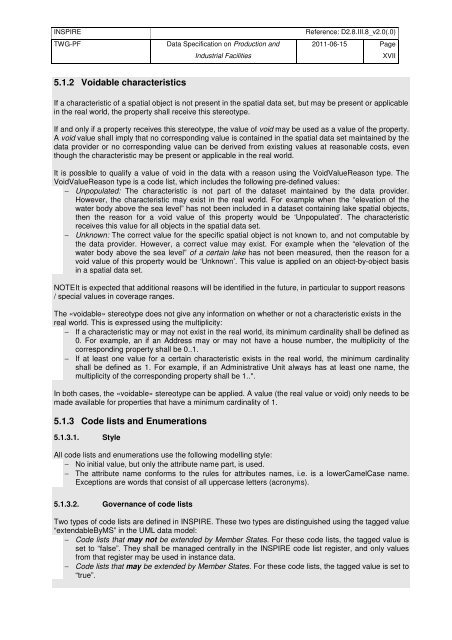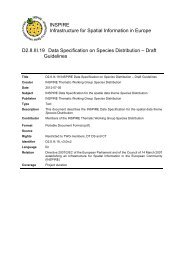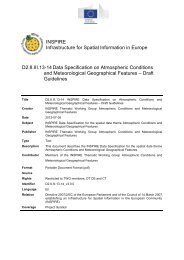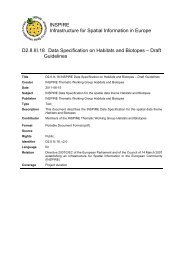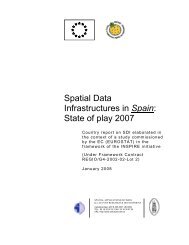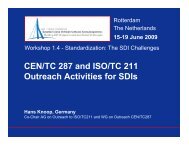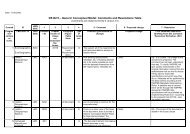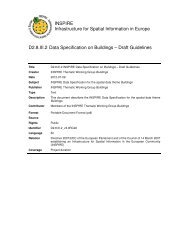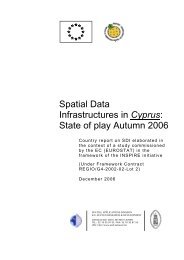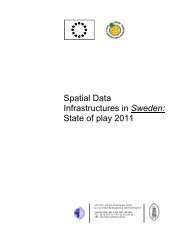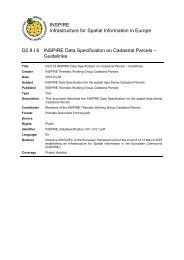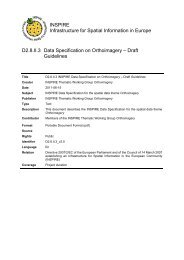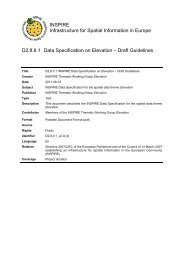Production and Industrial Facilities - INSPIRE - Europa
Production and Industrial Facilities - INSPIRE - Europa
Production and Industrial Facilities - INSPIRE - Europa
Create successful ePaper yourself
Turn your PDF publications into a flip-book with our unique Google optimized e-Paper software.
<strong>INSPIRE</strong> Reference: D2.8.III.8_v2.0(.0)<br />
TWG-PF Data Specification on <strong>Production</strong> <strong>and</strong><br />
5.1.2 Voidable characteristics<br />
<strong>Industrial</strong> <strong>Facilities</strong><br />
2011-06-15 Page<br />
If a characteristic of a spatial object is not present in the spatial data set, but may be present or applicable<br />
in the real world, the property shall receive this stereotype.<br />
If <strong>and</strong> only if a property receives this stereotype, the value of void may be used as a value of the property.<br />
A void value shall imply that no corresponding value is contained in the spatial data set maintained by the<br />
data provider or no corresponding value can be derived from existing values at reasonable costs, even<br />
though the characteristic may be present or applicable in the real world.<br />
It is possible to qualify a value of void in the data with a reason using the VoidValueReason type. The<br />
VoidValueReason type is a code list, which includes the following pre-defined values:<br />
− Unpopulated: The characteristic is not part of the dataset maintained by the data provider.<br />
However, the characteristic may exist in the real world. For example when the “elevation of the<br />
water body above the sea level” has not been included in a dataset containing lake spatial objects,<br />
then the reason for a void value of this property would be ‘Unpopulated’. The characteristic<br />
receives this value for all objects in the spatial data set.<br />
− Unknown: The correct value for the specific spatial object is not known to, <strong>and</strong> not computable by<br />
the data provider. However, a correct value may exist. For example when the “elevation of the<br />
water body above the sea level” of a certain lake has not been measured, then the reason for a<br />
void value of this property would be ‘Unknown’. This value is applied on an object-by-object basis<br />
in a spatial data set.<br />
NOTE It is expected that additional reasons will be identified in the future, in particular to support reasons<br />
/ special values in coverage ranges.<br />
The «voidable» stereotype does not give any information on whether or not a characteristic exists in the<br />
real world. This is expressed using the multiplicity:<br />
− If a characteristic may or may not exist in the real world, its minimum cardinality shall be defined as<br />
0. For example, an if an Address may or may not have a house number, the multiplicity of the<br />
corresponding property shall be 0..1.<br />
− If at least one value for a certain characteristic exists in the real world, the minimum cardinality<br />
shall be defined as 1. For example, if an Administrative Unit always has at least one name, the<br />
multiplicity of the corresponding property shall be 1..*.<br />
In both cases, the «voidable» stereotype can be applied. A value (the real value or void) only needs to be<br />
made available for properties that have a minimum cardinality of 1.<br />
5.1.3 Code lists <strong>and</strong> Enumerations<br />
5.1.3.1. Style<br />
All code lists <strong>and</strong> enumerations use the following modelling style:<br />
− No initial value, but only the attribute name part, is used.<br />
− The attribute name conforms to the rules for attributes names, i.e. is a lowerCamelCase name.<br />
Exceptions are words that consist of all uppercase letters (acronyms).<br />
5.1.3.2. Governance of code lists<br />
Two types of code lists are defined in <strong>INSPIRE</strong>. These two types are distinguished using the tagged value<br />
“extendableByMS” in the UML data model:<br />
− Code lists that may not be extended by Member States. For these code lists, the tagged value is<br />
set to “false”. They shall be managed centrally in the <strong>INSPIRE</strong> code list register, <strong>and</strong> only values<br />
from that register may be used in instance data.<br />
− Code lists that may be extended by Member States. For these code lists, the tagged value is set to<br />
“true”.<br />
XVII


